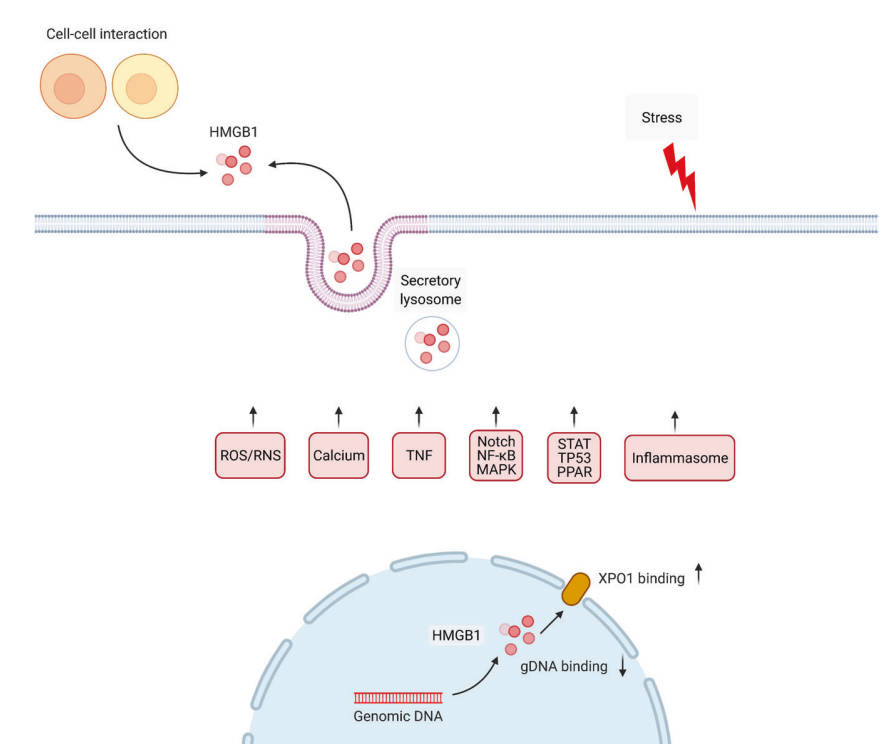Creative Biolabs is a well-recognized expert in the field of antibody generation and production. Especially, we have launched a series of in vitro diagnostic (IVD) antibody development services for different infections and diseases. Here, we introduce our IVD antibody and immunoassay development service for the high-mobility group box 1 (HMGB1), which is a promising biomarker for the diagnosis, prognosis, and monitoring of multiple cancers.
Introduction to HMGB1
HMGB1, a member of the high mobility group (HMG) protein family, is a highly conserved nuclear and extracellular protein. Structurally, HMGB1 consists of an 80-amino acid A Box, a B Box, and an acidic carboxyl tail. It has been implicated in a variety of biologically important processes, including transcription, DNA repair, differentiation, proliferation, and inflammation. In the nucleus, HMGB1 interacts with nucleosomes, transcription factors, and histones, thereby organizing the DNA and regulating DNA transcription.
There are two ways in which HMGB1 can be released into the extracellular space. One process is that HMGB1 can be actively secreted by different immune cells, such as neutrophils, monocytes, and macrophages, to act as a cytokine mediator of inflammation. When released into the extracellular fluid, it can bind several extracellular receptors, including the receptor for advanced glycation end products (RAGE) and toll-like receptors (TLRs), to initiate cell responses. The other process is that HMGB1 can be passively released from injured and necrotic cells. As a location-specific biological protein, HMGB1 mediates tissue-specific responses. Low levels of HMGB1 produced under appropriately controlled circumstances can mediate beneficial responses while high levels of HMGB1 cause acute damage. Elevated serum levels of HMGB1 have been found in different diseases, such as infectious diseases, inflammatory diseases, autoimmune diseases, and cancers.
 Fig.1 Active secretion of HMGB1 during stress.1
Fig.1 Active secretion of HMGB1 during stress.1
HMGB1 as A Marker for Cancer Diagnosis and Prognosis
HMGB1 has been identified as a multifunctional cytokine contributing to tumorigenesis, tumor angiogenesis, lymphangiogenesis, and metastasis. To date, increased expression of HMGB1 has been observed in various human tumors and cancers, including prostate cancer, lung cancer, hepatocellular carcinoma, gastric cancer, colorectal cancer, bladder cancer, nasopharyngeal carcinoma, head, and neck squamous cell carcinoma, mesothelioma, and esophageal squamous cancer cells. A number of studies have reported the potential and value of HMGB1 in the diagnosis and prognosis of the above cancer types.
IVD Antibody/Immunoassay Development Services Provided by Creative Biolabs
Creative Biolabs is a long-standing contract research organization specialized in the development of antibodies for research, diagnostic, and therapeutic applications. Particularly, we offer IVD antibody development services for a wide range of potential diagnostic markers. Moreover, with extensive experience in different immunoassay technology platforms, our team can help our clients with contract research in immunoassay design, assay development, optimization, validation, and production. Throughout the development of your assay, a dedicated and experienced team of scientists works on your product. For more information, please click the following links:
- IVD Antibody Development
- Antibody Pair Development
- Antibody & Protein Conjugation
- IVD Immunoassay Development

Features of Our Services
- Long-standing know-how and experience across a wide range of immunoassay formats
- Strong scientific background and wide-ranging and multi-disciplinary expertise
- Flexibility and adaptability to deliver services designed to suit specific demands
- Efficient customer communication and regular project updates
Please feel free to contact us to discuss how our expertise can lead to your success.
Reference
- Chen, Ruochan, Rui Kang, and Daolin Tang. "The mechanism of HMGB1 secretion and release." Experimental & molecular medicine 54.2 (2022): 91-102. Distributed under Open Access license CC BY 4.0, without modification.
For Research Use Only.

